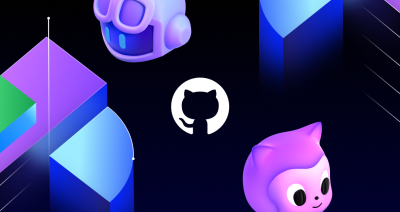Why Python keeps growing, explained
A deep dive into why more people are using Python than ever, its key use cases, and why it’s still so popular 30-plus years after it was first released.

Which programming language has been around for more than three decades and continues to grow in popularity each year?
If you guessed Python, you nailed it. In the 2022 Octoverse report, we found that Python remains the second most-used programming language on GitHub. Interestingly, Python’s use grew more than 22 percent year over year with more than four million developers on GitHub using it at some point in 2022.
In this article, we’ll dive into a brief history of Python, its benefits, its use cases, and seek to answer why a program language conceived in the 1980s continues to dominate development. And, since this is GitHub, we’ll also offer a few useful tips and tricks for developers new to—and experienced in—Python.
So, what is Python? 🤔
Python is a high-level, interpreted programming language with a simple syntax, which makes it easily readable and extremely user- and beginner-friendly. Originally built to satisfy Guido Van Rossum’s desire for a programming language that was simple to use and beautiful to look at, Python was first released to the world in 1991.
Fun fact: Python was named after the BBC TV show, “Monty Python’s Flying Circus.”
Since its development, it has grown to have widespread applicability for developers, data scientists, researchers, and more. But how, you may ask, can a coding language be simple and beautiful to look at? Here’s some proof:
Python
print("Hello world.")
vs.
Java
public class HelloWorld {
public static void main (String[]args) {
System.out.println.("Hello world");
}
}
Since Python is a general-purpose language, it can be used in a variety of applications, and its uncomplicated nature makes it an excellent language for automating tasks, building websites or software, and analyzing data.
Python also has several other characteristics that make it popular amongst developers and engineers. These include:
- It’s easy to read. Python code uses English keywords rather than punctuation, and its line breaks help define the code blocks. In practice, this means you can identify what the code is designed to do simply by looking at it.
-
It’s open source. You can download the source code, modify it, and use it however you want.
-
It’s portable. Some languages require you to modify code to run on different platforms, but Python is a cross-platform language, which means you can run the same code on any operating system with a Python interpreter.
-
It’s extendable. Python code can be written in other languages (such as C++), and users can add low-level modules to the Python interpreter to customize and optimize their tools.
-
It has a broad standard library. This library is available for anyone to access and means that users don’t have to write code for every single function—they can access built-in modules that help with issues in everyday programming and more.
What is Python commonly used for? 💻
Python can be used for just about anything, from web and software development to machine learning and artificial intelligence (AI). Let’s take a look at some of its most common use cases.
import antigravity
def main():
antigravity.fly()
if __name__ == '__main__':
main()
Run this command to check out an inside joke among Python developers.
Using Python for web and software development
Python is a popular language for web and software development because you can create complex, multi-protocol applications while maintaining concise, readable syntax. In fact, some of the most popular applications were built with Python. Plus, Python’s open source community provides developers with an extensive amount of reusable code, frameworks, and support. Case in point: Django is one of the most-used Python frameworks designed by experienced developers to help others accelerate their application build times and avoid issues that might balk their progress.
Using Python for task automation
One of Python’s key benefits is its ability to automate manual, repetitive tasks. With Python, you can learn how to automate just about anything by using either built-in modules or pre-written code from its robust library. Or you can write your own custom scripts to perform specific actions. For example, you can easily automate emails with the “smtplib” module or copy files with the “shutil” module. Python also has a robust set of testing frameworks, which makes it an excellent language for test automation. Frameworks such as Pytest, Behave, and Robot allow developers to write simple yet effective tests to ensure the quality of their builds.
Using Python for machine learning and data science
Here’s a fun fact: Python is the top preferred language for data science and research. Since its syntax is easily understandable and adaptable, people with little-to-no development experience can easily learn Python and use it to manipulate data for research, reporting, predictable or regression analyses, and more. Collecting and parsing data can be a time-consuming task for data scientists. Python is also one of the top languages for training machine learning (ML) models. Through specific algorithms, these models can analyze and identify patterns in data to make predictions or decisions based on that data. They also constantly evolve based on outputs of previous datasets to confront new variables. Data scientists and developers training ML models often utilize libraries, such as NumPy, Pandas, and Matplotlib, to automate functions like cleaning, data transformation, and visualization.
Using Python for financial analysis
Similar to how Python can assist data scientists with the heavy lift of large data sets, Python is widely used in the financial industry to quickly perform complex computations. Stock markets generate huge amounts of data, and Python can be used to import data on stock prices and generate strategies through algorithms to identify trading opportunities. The language can also be used for portfolio optimization, risk management, financial modeling and visualization, cryptocurrency analysis, and even fraud detection.
Using Python for and artificial intelligence
Python can also be found in some of the most complex, artificial intelligence (AI) technologies—and it’s actually one of the preferred languages for AI. Python’s concise and readable code allows developers to create consistent, reliable systems, and its vast library provides a number of frameworks like PyBrain, which offers developers powerful algorithms for machine learning tasks. Plus, Python’s visualization capabilities can help convert these large datasets for AI or ML into comprehensible graphs or reports. Interestingly enough, OpenAI, the artificial intelligence research lab, utilizes the Python framework, Pytorch, as their standard framework for deep learning, which trains its AI systems.
Why is Python so popular? 🙌
In addition to its relative simplicity to learn, there are a few other reasons why Python continues to consistently grow in popularity. These include:
- It’s more productive. Compared to some other more complex programming languages like C++, Python’s syntax allows users to do more with less and cut down on time and effort to write the same lines of code.
-
It has an expansive, supportive community of users. Even the best developers run into problems— and this is where user communities can become an invaluable resource. Python has a huge community with documentation, tutorials, tips, and tricks to master the language. The Python community on GitHub, for example, offers everything from information on the latest version of the language to bug reports and update notes.
-
It’s academic. Python has become the go-to language in academia with some students even encountering Python as early as elementary school. (Believe it or not, there are children’s picture books dedicated to Python.) While computer science students are often taught Python, its use extends beyond that discipline into other areas of STEM and academic research. For example, Python can be used to solve differential equations, perform statistical analyses, simulate and track particle diffusion, and more.
-
It has high corporate demand. Because of its wide scale applicability in development and data analysis work, learning and knowing Python is often considered a top-skill among job seekers. According to Statista, Python was the third most demanded language in 2022 by recruiters worldwide.
The bottom line
Python is everywhere—and it’s been used to build a significant number of the technologies, websites, and even systems most people encounter on a daily basis. It powers everything from your favorite video streaming service to the ML algorithms that can help you make your next cryptocurrency trade. And for an even broader scope example (pun absolutely intended), NASA uses Python to power data analysis with its sophisticated James Webb Space Telescope, which makes it one of the few programming languages that is, quite literally, out of this world. 🚀
How to get started with Python 📓
A quick Google search will yield hundreds of resources out there to jumpstart your Python journey—and that can quickly get a little overwhelming. To simplify things, here are a few helpful GitHub repositories to help you get started with Python:
- Explore pre-built Python algorithms: From networking flows to physics and neural networks, this repository is a great guide to building algorithms in Python.
- Learn Python in 30 days: This step-by-step guide will walk you through the basics of Python in 30 days.
- Grab some tips from this cheatsheet: Check out this collection of Python scripts with code examples and explanations for learning the language.
- Sharpen your Python skills: Pick up some tips from this study guide for both beginner and seasoned users built by a Python superfan!
To get started, download the latest version of Python.
Start building on GitHub today
GitHub offers two easier ways to start working with Python: GitHub Codespaces and GitHub Copilot.
You can start building today for free with GitHub Codespaces, which every developer on GitHub gets 60 free hours of use time per month to spin up a development environment in the cloud from any device at speed. Check out the Django quick start template to begin coding right in your browser!
You can also use GitHub Copilot, GitHub’s AI pair programmer, to write your first lines of Python. Here’s how:
- Install the GitHub Copilot extension into your code editor.
- Describe the purpose of your project in a comment.
- Write a comment describing which libraries you may need.
- Start tabbing and let GitHub Copilot suggest lines of code to help you learn new techniques or methods.
From machine learning to data analysis, Python’s versatility allows it to continue its explosive growth with developers and non-developers alike. Experiment with Python through GitHub or on your local machine to be part of this growth and get started today!
Tags:
Written by
Related posts

Why developer expertise matters more than ever in the age of AI
AI can help you code faster, but knowing why the code works—and sharpening your human-in-the-loop skills—is what makes you a great developer.

How to create issues and pull requests in record time on GitHub
Learn how to spin up a GitHub Issue, hand it to Copilot, and get a draft pull request in the same workflow you already know.

The difference between coding agent and agent mode in GitHub Copilot
We’ll decode these two tools—and show you how to use them both to work more efficiently.